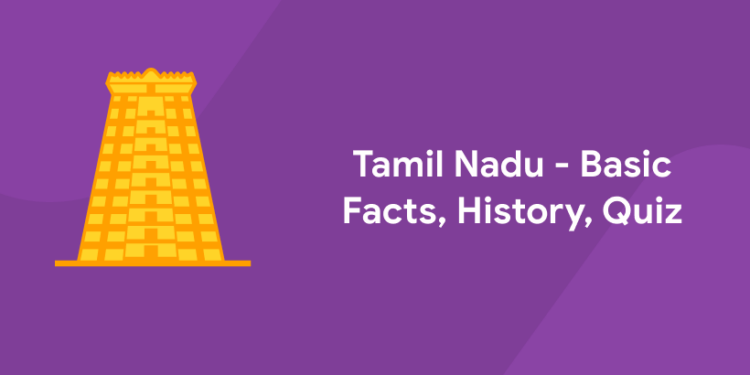Tamil Nadu is an Indian state in the subcontinent’s extreme south. It is bordered on the east and south by the Indian Ocean, and on the west, northwest, and north by the states of Kerala, Karnataka (previously Mysore), and Andhra Pradesh. The enclaves of Puducherry and Karaikal, both part of the Puducherry union territory, are encircled by Tamil Nadu along the north-central coast. Chennai (Madras), the state capital, is located on the coast in the northeastern part of the country.
Tamil Nadu is the Tamil-speaking region of British India’s Madras Presidency. Tamils are especially proud of their Dravidian language and culture, and they have fought the central government’s attempts to make Hindi (an Indo-Aryan language) the sole national language. The state is primarily agricultural, although having an industrial centre in Chennai. 50,216 square miles is the total area of the country (130,058 square km).
Physiographic Region:
The flat terrain along the eastern coast and the mountainous regions in the north and west naturally separate Tamil Nadu. The lush Kaveri (Cauvery) River delta is the widest area of the eastern plains; farther south are the dry flatlands that surround the towns of Ramanathapuram and Madurai (Madura). The Western Ghats’ high peaks run along the state’s western boundary. Several sections of this mountain range, notably the Nilgiri, Anaimalai, and Palni hills, have peaks that exceed 8,000 feet (2,400 metres). The highest mountain in peninsular India is Anai Peak, which stands at 8,842 feet (2,695 metres) in the Anaimalai Hills. The Javadi, Kalrayan, and Shevaroy hills, as well as the lower peaks of the Eastern Ghats and their outliers, pass through the heart of the area. The Kaveri, the Ponnaiyar, the Palar, the Vaigai, and the Tambraparni all run eastward from the interior highlands of Tamil Nadu.
History:
The Chera, Chola, and Pandya kingdoms, all of unknown antiquity, established a trinity of Tamil powers in the region, namely the Chera, Chola, and Pandya kingdoms. These kingdoms had diplomatic and commercial ties with other countries. The Pandyas were referenced in Greek literature as early as the 4th century BCE, and a Pandyan embassy was received by Roman Emperor Julian in the 4th century CE. Meanwhile, the Chera dynasty maintained a thriving commercial relationship with western Asia.
The Chalukyas of Badami, the Pallavas of Kanchi (now Kanchipuram), and the Pandyas of Madurai fought a lengthy series of conflicts in the region from the mid-6th century to the 9th century. Despite this, the time saw a renaissance of Hinduism and the advancement of the fine arts. The Cholas ruled Tamil Nadu from around 850, with Rajendrachola Deva I (reigned 1014–44) being the most notable emperor. The Hindu kingdom of Vijayanagar rose to prominence in the mid-14th century, encompassing all of Tamil Nadu. During Vijayanagar’s 300 years in power, Telugu-speaking rulers and officials were appointed to the administration.
With the approval of the local monarch, the English East India Company established a trade post in Madraspatnam (now Chennai) in 1640. The British-controlled Madras Presidency’s growth and fall in connection to the rise and fall of British authority in India is the storey of Tamil Nadu from the mid-17th century until 1946. Madras Presidency became Madras State when India gained independence in 1947. In 1953, the Telugu-speaking portions of the state were split off and became part of the new state of Andhra Pradesh. In 1956, Madras was further partitioned, with some districts becoming part of the newly formed state of Kerala and others becoming part of the state of Mysore (now Karnataka). In 1968, the state of Madras was renamed Tamil Nadu from what was left of the Madras state.
Basic facts about Tamil Nadu:
|
Tamil Nadu |
|
| Capital: | Chennai |
| Size: | 1,30,058 sq km |
| Districts: | 38 |
| Formed on: | The Government of India established Madras State on January 26, 1950. The state’s boundaries were reorganised along linguistic lines as a result of the 1956 States Reorganisation Act. On 14 January 1969, Chief Minister C.N.Annadurai officially called the state Tamil Nadu. |
| Official Language: | Tamil |
| Known as: | It is well-known for its temples and architecture, as well as cuisine, films, and traditional Indian dance and music. |
| Famous Dances: | Bharat Natyam is the popular traditional dance of the state.
Kolattam, Karagam, and Mayilattam are famous folk dances. |
| State Animal: | Nilgiri Tahr |
| State Bird: | Emerald Dove |
| State Flower: | Glory Lily or Kandhal |
| State Tree: | Palmera Palm |
| National Parks: | Mudumalai NP, Mukurthi NP, Annamalai NP |
| Rivers: | Kaveri, Palar, Pniyar, Bhavani |
| Wildlife Sanctuaries: | Mudumalai Wildlife Sanctuary, Point Calimere Wildlife Sanctuary, Indira Gandhi Wildlife Sanctuary, Mundanthurai Wildlife Sanctuary. |
| Nuclear Power Stations: | Madras Atomic Power Station, Kalpakkam, Kudankulam Nuclear Power Plant, Kudankulam |
| Thermal Power Stations: | Neyveli Thermal Power Station, Cuddalore, Mettur Thermal Power Station, Salem, Ennore Thermal Power Station, Chennai. |
| Famous Places in Tamil Nadu: | Marina Beach, Meenakshi Amman Temple, Kanyakumari beach, Vivekananda Rock Memorial, Gandhi Museum and Thanjavur Temple. |
GK Quiz on Tamil Nadu:
Q: In Tamil Nadu, the first railway station was erected at
Ans: Royapuram
Q: Tamil Nadu’s Aryankavu Pass is located in?
Ans: Agastya hills
Q. In which Grand Slam event did Nirupama Sanjeev make history by becoming the first Indian woman to play in a main draw and win a round in 1998?
Ans: Australian Open
Q. Which Tamil Nadu city is also known as the temple city?
Ans: Madurai
Q. In Tamil Nadu, where is the Veterinary University?
Ans: Chennai
Q. Which of Tamilnadu’s districts has the greatest population?
Ans: Chennai
Q. Who wrote Kural, which is considered to be the Tamil Veda?
Ans: Tiruvalluvar
Q. Which of Tamilnadu’s districts is the largest in terms of area?
Ans: Viluppuram
Q. Who among the following was known as Tamil Nadu’s Dadabhai?
Ans: Vijayaragavachariyar
Q. What Tamil Nadu city is sometimes regarded as the Oxford of South India?
Ans: Palayamkottai
Q. Who was the author of the Amuktamalyada text?
Ans: Krishnadevaraya
Q. The sanskrit work Kumara Kamparaya Charitam was written by
Ans: Ganga Devi
Q. Which city is also regarded as Tamil Nadu’s Textile Capital?
Ans: Karur
Q. In which district is the Srivilliputhur Andal temple located?
Ans: Virudhunagar
Q. Who is referred to as the “Father of the Pure Tamil Movement”?
Ans: Maraimalai Adigal












